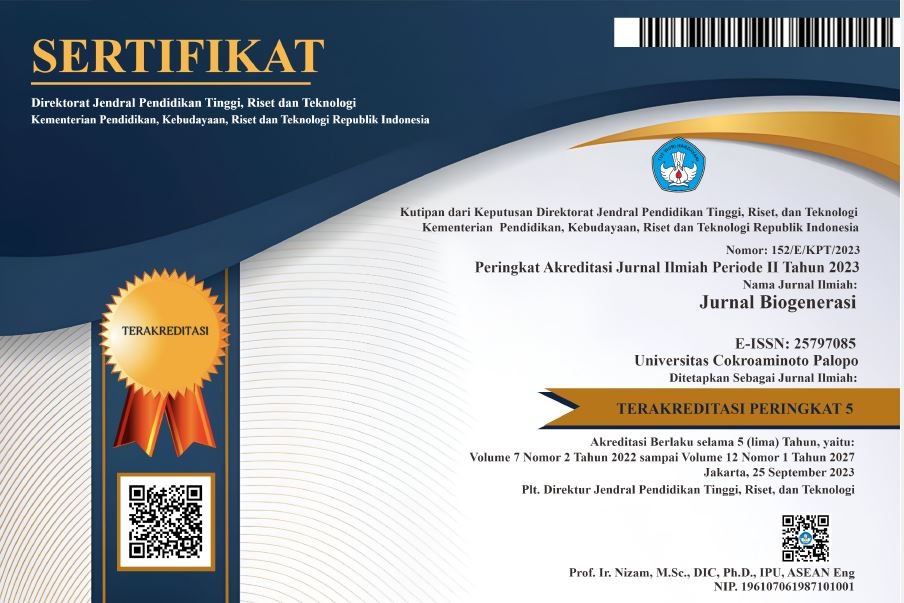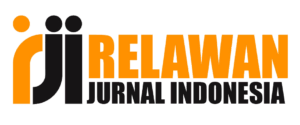KONTAMINASI MIKROPLASTIK DI USUS DAN INSANG IKAN LAUT KOMERSIAL DARI TELUK JAKARTA
DOI:
https://doi.org/10.30605/biogenerasi.v10i3.6930Keywords:
microplastic, commercial fish, Jakarta Bay, food safety, marine pollutionAbstract
The rapid growth of seafood consumption has raised concerns about food safety due to microplastic contamination in marine organisms. This study investigated the occurrence and characteristics of microplastics in commercially important marine fish marketed in Jakarta Bay, one of Indonesia’s most densely populated and industrialized coastal regions. A total of 160 specimens representing eight species were collected from five major fish markets between December 2023 and January 2024. Microplastics were extracted from gills and gastrointestinal tracts using enzymatic digestion, density separation, and confirmed by ATR-FTIR spectroscopy. Results revealed that 93.8% of the samples contained microplastics, with an average of 3.65 ± 2.34 particles per individual (0.12 ± 0.21 particles/g). Carnivorous and benthopelagic species exhibited significantly higher contamination levels compared to omnivorous and planktivorous species. Most particles were fragments and fibers (~70%), predominantly within the 2000-5000 µm size range. Seven polymer types were identified, with polyethylene, polypropylene, and polystyrene as the most frequent. These findings indicate that Jakarta Bay is a hotspot of plastic pollution, posing potential risks to food security and public health. Continuous monitoring, standardized risk assessments, and improved waste management strategies are urgently needed to mitigate the impacts of microplastic contamination on fisheries and human consumers.
Downloads
References
Ajith N, Arumugam S, Parthasarathy S, Manupoori S, Janakiraman S. 2020. Global distribution of microplastics and its impact on marine environment—a review. Environmental Science and Pollution Research. 27(21):25970-25986. doi: https://doi.org/10.1007/s11356-020-09015-5
Barboza LGA, Lopes C, Oliveira P, Bessa F, Otero V, Henriques B, Raimundo J, Caetano M, Vale C, Guilhermino L. 2020. Microplastics in wild fish from North East Atlantic Ocean and its potential for causing neurotoxic effects, lipid oxidative damage, and human health risks. Science of the Total Environment. 717:134625. doi: https://doi.org/10.1016/j.scitotenv.2019.134625
Barceló D, Picó Y, Alfarhan AH. 2023. Microplastics: Detection in human samples, cell line studies, and health impacts. Environmental Toxicology and Pharmacology. 101:104204. doi: https://doi.org/10.1016/j.etap.2023.104204
BPS. 2024. Rata-rata konsumsi ikan per kapita per minggu menurut provinsi. Jakarta: Badan Pusat Statistik.
Brennecke D, Duarte B, Paiva F, Caçador I, Canning-Clode J. 2016. Microplastics as vector for heavy metal contamination from the marine environment. Estuarine, Coastal and Shelf Science. 178:189-195. doi: https://doi.org/10.1016/j.ecss.2015.12.003
Cordova MR, Nurhati IS. 2019. Major sources and monthly variations in the release of land-derived marine debris from the Greater Jakarta area, Indonesia. Scientific Reports. 9:18730. doi: https://doi.org/10.1038/s41598-019-55065-2
Cordova MR, Riani E, Shiomoto A. 2020. Microplastics ingestion by blue panchax fish (Aplocheilus sp.) from Ciliwung Estuary, Jakarta, Indonesia. Marine Pollution Bulletin. 161:111763. doi: https://doi.org/10.1016/j.marpolbul.2020.111763
Cordova MR, Ulumuddin YI, Purbonegoro T, Puspitasari R, Afiani D, Rositasari R, dkk. 2022. [artikel MPB 2022; sesuai file pertama]. Marine Pollution Bulletin. 181:113926. doi: https://doi.org/10.1016/j.marpolbul.2022.113926
Cordova MR, Ulumuddin YI, Purbonegoro T, Puspitasari R, Rositasari R, Yogaswara D, Kaisupy MT, Wibowo SPA, Subandi R, Sani SY, Sulistyowati S, et al. 2024. Abundance and characterization of microplastic pollution in wildlife reserve, Ramsar site, and national park in northern Jakarta and Seribu Islands, Indonesia. Chemosphere. 348:140761. doi: https://doi.org/10.1016/j.chemosphere.2023.140761
De Frond H, Rubinovitz R, Rochman CM. 2021. μATR-FTIR spectral libraries of plastic particles (FLOPP and FLOPP-e) for the analysis of microplastics. Analytical Chemistry. 93(48):15878-15885. doi: https://doi.org/10.1021/acs.analchem.1c02549
Enders K, Lenz R, Stedmon CA, Nielsen TG. 2015. Abundance, size and polymer composition of marine microplastics ≥10 μm in the Atlantic Ocean and their modelled vertical distribution. Marine Pollution Bulletin. 100(1):70–81. doi: https://doi.org/10.1016/j.marpolbul.2015.09.027
Harikrishnan S, Chithra E, Sasi N, Ramya A, Chitra PS. 2023. Microplastics in edible fish tissues and human health risk assessment: a systematic review. Chemosphere. 313:137486. doi: https://doi.org/10.1016/j.chemosphere.2022.137486
Horton AA, Jürgens MD, Lahive E, van Bodegom PM, Vijver MG. 2018. Influence of exposure and physiology on microplastic ingestion by roach (Rutilus rutilus) in the River Thames. Environmental Pollution. 236:188-194. doi: https://doi.org/10.1016/j.envpol.2018.01.044
Ineyathendral TR, Govindarajulu B, Priyanka R. 2023. Characterization and distribution of microplastics in commercial fishes along Chennai coast. Environmental Nanotechnology, Monitoring and Management. 20:100898. doi: https://doi.org/10.1016/j.enmm.2023.100898
Int-Veen I, Nogueira P, Isigkeit J, Hanel R, Kammann U. 2021. Polybutadiene particles as tire wear in aquatic environments. Marine Pollution Bulletin. 172:112876. doi: https://doi.org/10.1016/j.marpolbul.2021.112876
Justino AKS, Ferreira GVB, Fauvelle V, Schmidt N, Lenoble V, Pelage L, Martins K, Travassos P, Lucena-Frédou F. 2023. Evidence of microplastic trophic transfer in tuna and large pelagic species in the Tropical Atlantic. Environmental Pollution. 327:121532. doi: https://doi.org/10.1016/j.envpol.2023.121532
Karami A, Golieskardi A, Choo CK, Larat V, Karbalaei S, Salamatinia B. 2018. Microplastic and mesoplastic contamination in canned sardines and sprats. Science of the Total Environment. 612:1380-1386. doi: https://doi.org/10.1016/j.scitotenv.2017.09.005
Krause S, Baranov V, Nel HA, Drummond JD, Kukkola A, Hoellein T, et al. 2021. Environmental controls of microplastic uptake and biomagnification in freshwater food webs. Environmental Pollution. 268:115750. doi: https://doi.org/10.1016/j.envpol.2020.115750
Lehtiniemi M, Hartikainen S, Näkki P, Engström-Öst J, Koistinen A, Setälä O. 2018. Size matters more than shape: Ingestion of primary and secondary microplastics by small predators. Food Webs. 17:e00097. doi: https://doi.org/10.1016/j.fooweb.2018.e00097
Lopes C, Raimundo J, Caetano M, Garrido S. 2020. Microplastic ingestion and diet composition of planktivorous fish. Limnology and Oceanography Letters. 5(1):103–112. doi: https://doi.org/10.1002/lol2.10144
Lusher AL, McHugh M, Thompson RC. 2013. Occurrence of microplastics in the gastrointestinal tract of pelagic and demersal fish from the English Channel. Marine Pollution Bulletin. 67(1–2):94–99. doi: https://doi.org/10.1016/j.marpolbul.2012.11.028
Lyu W, Chen Q, Cheng L, Zhou W. 2020. Microplastics in aquaculture systems and their transfer in the food chain. Handbook of Environmental Chemistry. doi: https://doi.org/10.1007/698_2020_455
Omeyer LCM, Duncan EM, Bowdery H, Tilley D, Abreo NAS, Boxall M, dkk. 2022. A global synthesis of marine megafauna interactions with plastic pollution. Nature Communications. 13:2719. doi: https://doi.org/10.1038/s41467-022-30134-z
Pironti C, Notarstefano V, Ricciardi M, Motta O, Giorgini E, Montano L. 2023. First evidence of microplastics in human urine: a preliminary study. Toxics. 11(1):32. doi: https://doi.org/10.3390/toxics11010040
Sathish N, Jeyasanta KI, Patterson J. 2020. Microfibers from synthetic textiles as a major source of microplastics in the environment: a review. Environmental Science and Pollution Research. 27(36):45900–45918. doi: https://doi.org/10.1007/s11356-020-10479-7
Simon-Sánchez L, Martin J, Grelaud M, Lorenz C, Garcia-Orellana J, Vianello A, dkk. 2022. Microplastic preservation in a coastal sedimentary record. Environmental Science & Technology. 56(23):16780–16788. doi: https://doi.org/10.1021/acs.est.2c04264
Su L, Deng H, Li B, Chen Q, Pettigrove V, Wu C, Shi H. 2019. Occurrence of microplastic in organs of fish from East China. Journal of Hazardous Materials. 365:716-724. doi: https://doi.org/10.1016/j.jhazmat.2018.11.024
Teixeira CM, Silva PM. 2024. The huge dilemma: how to increase seafood consumption without compromising sustainability? International Journal of Food Science and Technology. 59(2):661-672. doi: https://doi.org/10.1111/ijfs.16841
Wright SL, Kelly FJ. 2017. Plastic and human health: A micro issue? Environmental Science & Technology. 51(12):6634-6647. doi: https://doi.org/10.1021/acs.est.7b00423
Zakiah YS, Riani E, Taryono, Cordova MR. 2024. Assessment of microplastic contamination in a tropical estuary [judul sesuai file pertama]. Environmental Forensics. 25:1–14. doi: https://doi.org/10.1080/15275922.2023.2297434
Downloads
Published
How to Cite
Issue
Section
License
Copyright (c) 2025 Singgih Prasetyo Adi Wibowo, Muhammad Taufik Kaisupy, Muhammad Reza Cordova

This work is licensed under a Creative Commons Attribution 4.0 International License.
In submitting the manuscript to the journal, the authors certify that:
- They are authorized by their co-authors to enter into these arrangements.
- The work described has not been formally published before, except in the form of an abstract or as part of a published lecture, review, thesis, or overlay journal.
- That it is not under consideration for publication elsewhere,
- That its publication has been approved by all the author(s) and by the responsible authorities – tacitly or explicitly – of the institutes where the work has been carried out.
- They secure the right to reproduce any material that has already been published or copyrighted elsewhere.
- They agree to the following license and copyright agreement.
License and Copyright Agreement
Authors who publish with this journal agree to the following terms:
- Authors retain copyright and grant the journal right of first publication with the work simultaneously licensed under Creative Commons Attribution License (CC BY 4.0) that allows others to share the work with an acknowledgment of the work's authorship and initial publication in this journal.
- Authors are able to enter into separate, additional contractual arrangements for the non-exclusive distribution of the journal's published version of the work (e.g., post it to an institutional repository or publish it in a book), with an acknowledgment of its initial publication in this journal.
- Authors are permitted and encouraged to post their work online (e.g., in institutional repositories or on their website) prior to and during the submission process, as it can lead to productive exchanges, as well as earlier and greater citation of published work.


.png)

